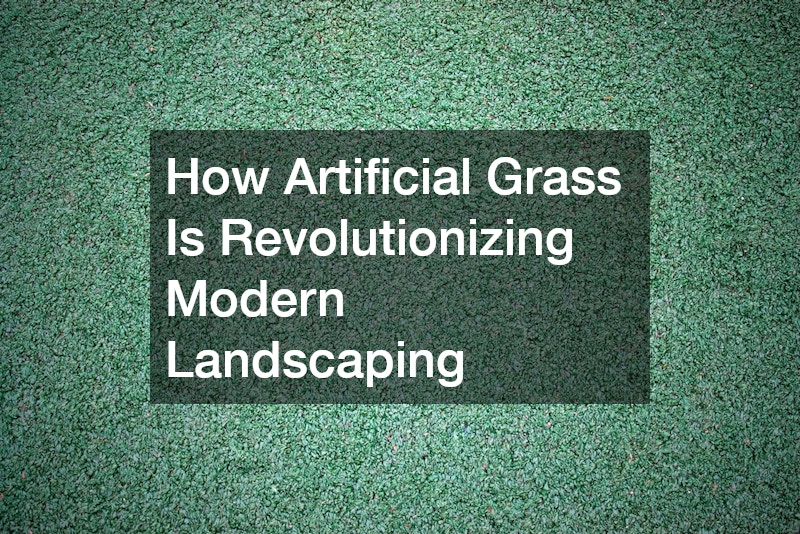In recent years, the use of artificial grass has surged, becoming an integral part of modern landscaping trends. This shift can be attributed to the growing demand for sustainable, low-maintenance landscaping solutions. As more people seek to reduce their environmental footprint, artificial grass offers a viable alternative that addresses both ecological concerns and practical needs.
The Advantages of Using Artificial Grass in Landscaping
Environmental Benefits
Artificial grass is renowned for its contribution to water conservation, an important factor in regions plagued by water shortages. Unlike natural grass, synthetic turf does not require watering, allowing property owners to significantly reduce their water usage.
Additionally, by eliminating the need for fertilizers and pesticides, artificial grass contributes to reducing the chemical load on the environment, promoting eco-friendly landscaping practices.
Moreover, artificial grass helps to decrease the emissions associated with lawn maintenance equipment. Traditional gas-powered mowers and trimmers contribute to air and noise pollution, which is mitigated by opting for artificial solutions. The tangible environmental benefits are complemented by the aesthetic appeal of pristine, evergreen turf that does not compromise on quality.
In public spaces, such as parks and sports fields, artificial grass enables year-round usability without the environmental cost of natural grass upkeep. It stands up well to high foot traffic and inclement weather, maintaining its lush appearance. These factors make artificial turf an increasingly popular option for municipalities focused on sustainability and community satisfaction.
Cost-Efficiency Over Time
While the initial costs for installing artificial grass can be higher than seeding or sodding a natural lawn, the long-term financial benefits are significant. Artificial lawns eliminate recurring expenses related to watering, mowing, fertilizing, and treating natural grass problems like weeds and pests. Over time, the return on investment becomes evident as maintenance costs virtually drop to zero.
Furthermore, artificial grass is known for its longevity, often lasting upwards of 15 years with proper care. This durability reduces the frequency and cost of replacements compared to natural sod that may suffer damage from pests, drought, or overuse. As a result, many property owners find that the upfront investment pays for itself within a few years, boosting the appeal of synthetic options.
Considering the cost of seasonal care and labor needed for natural lawn maintenance, artificial grass provides a clear economic advantage. It offers homeowners and businesses a way to achieve a lush, attractive landscape without the ongoing expenses or effort of maintaining natural grass. This financial practicality continues to drive its adoption in diverse landscaping projects.
How Artificial Grass Compares to Natural Grass
Aesthetic Appeal
Technological advancements have significantly enhanced the aesthetic quality of artificial grass, making it nearly indistinguishable from natural grass. Modern synthetic turf is available in a variety of colors, textures, and blade lengths, allowing property owners to customize based on their aesthetic preferences. The result is an evergreen and uniformly lush appearance that many find appealing year-round.
Moreover, artificial grass offers a consistent visual appeal that does not succumb to seasonal browning or patchiness. Unlike natural grass, which can become discolored or thin during droughts or cold weather, synthetic turf maintains a vibrant green look. This ensures that lawns, sports fields, and playgrounds remain inviting and attractive, regardless of weather conditions.
Durability and Maintenance
Artificial grass is renowned for its durability, standing up to heavy use without suffering the wear and tear common to natural grass. It handles intense activities such as sports, pets, and daily foot traffic with ease, maintaining its lush appearance. Unlike natural grass, which can become compacted and damaged, artificial surfaces remain resilient and stable.
Maintaining artificial grass requires minimal effort, with no mowing, watering, or fertilizing needed. Owners typically need only occasional rinsing to remove dust or debris, and brushing to maintain the upright position of the blades. This simplicity in maintenance is one of the key factors driving the swift adoption of artificial grass in both residential and commercial projects.
The Challenges and Considerations When Installing Artificial Grass
Installation Process
Artificial grass installation involves a systematic process that is crucial for ensuring its longevity and appearance. It begins with meticulous site preparation, including removing existing lawn, leveling the surface, and installing a robust drainage system. Choosing the right product suited to specific requirements is also important to address usage, durability, and aesthetic needs.
Properly installed artificial turf ensures optimal performance and a natural look, making professional installation a popular choice. Experts have the experience to ensure appropriate base layers, seam joining, and edge securing, which are vital for preventing future issues. While DIY installation can be a cost-saving option, professional services guarantee quality outcomes aligned with the investment.
Potential Issues and Solutions
Despite its advantages, certain challenges can arise with artificial grass, such as drainage concerns and heat retention. Poor drainage can lead to water pooling, which can be mitigated through proper groundwork and using permeable base layers. Additionally, advanced products often incorporate cooling technology or special infill materials to combat excessive heat buildup in sunny climates.
Maintenance of artificial grass also involves addressing potential hygiene concerns, especially in spaces used by pets or children. Regular cleaning regimes, including rinsing and occasional sanitization, can help maintain a hygienic environment. Addressing these considerations proactively ensures that artificial grass remains a functional and pleasant addition to any landscape.
Artificial grass has proven to be a revolutionary change in modern landscaping, aligning with ecological, economic, and practical considerations. It offers sustainable advantages through water conservation, reduced emissions, and minimal maintenance requirements. However, like any innovation, it requires thorough understanding and planning to navigate its challenges and maximize its benefits for long-lasting landscape satisfaction.

